A Look Back at 50 Years of Public Art in NYC Parks
Since 1967, our Art in the Parks program, founded by Doris C. Freedman, has brought more than 2,000 art installations to parks all across New York City—bringing art to all! Some made us laugh, some challenged the way we think about the environment and each other, while some revolutionized the way we experience public spaces.
In 2017, we celebrated the 50th anniversary of public art in NYC Parks. Take a look back:
Remember When ....
We walked under 7,500 saffron "gates" in Central Park,
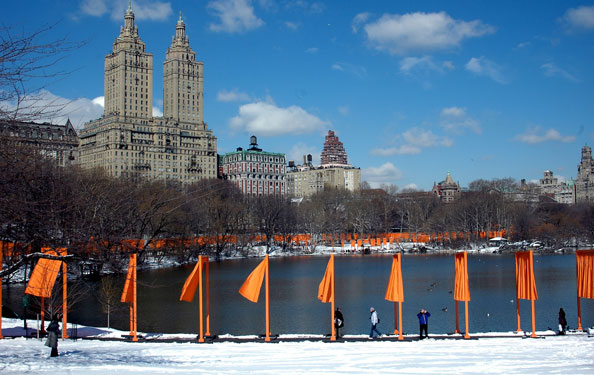 Christo and Jeanne-Claude, "The Gates," 2005, Central Park, Manhattan, Photo by Malcolm Pinckney
Christo and Jeanne-Claude, "The Gates," 2005, Central Park, Manhattan, Photo by Malcolm Pinckney
Four million visitors came to see the artwork in its brief run, from February 12 to 28, placed—for 23 miles—along pathways in Central Park. The artists Christo and Jeanne-Claude, who specialized in temporary public art, explained that “Our works are temporary in order to endow the works of art with a feeling of urgency to be seen, and the love and tenderness brought by the fact that they will not last.”
we saw the Washington Square Arch wrapped like a giant bandage,
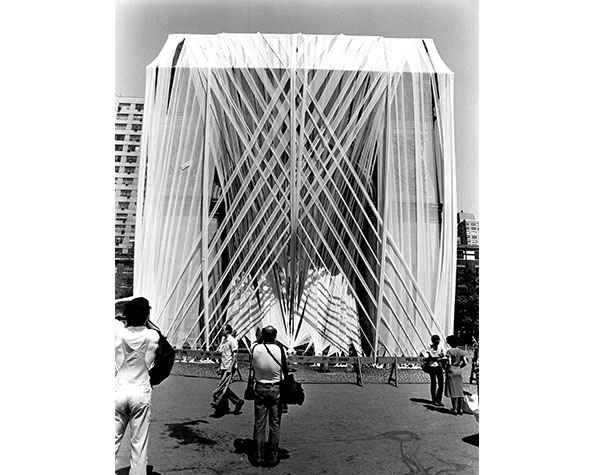 Francis Hines, "Washington Square Arch Wrap," 1980, Washington Square Park, Manhattan, NYC Parks Photo Archive
Francis Hines, "Washington Square Arch Wrap," 1980, Washington Square Park, Manhattan, NYC Parks Photo Archive
In 1980, Francis Hines bound the iconic Washington Square Arch in 8,000 strips of polyester gauze, described as a giant bandage for a wounded monument. Sponsored by NYU, the installation was used to raise funds to restore the monument and park.
and welcomed the Loch Ness Monster to Marine Park?
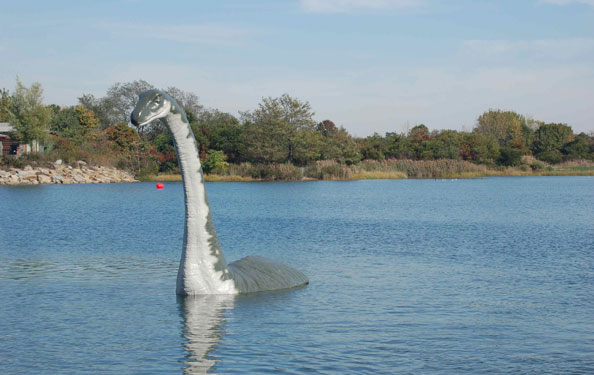 Cameron Gainer, "Nessie," 2007, Marine Park, Brooklyn, NYC Parks
Cameron Gainer, "Nessie," 2007, Marine Park, Brooklyn, NYC Parks
Cameron Gainer staged a replica of the mythic serpent in the salt marsh off of Marine Park. On the morning of April 19, 1934, British gynecologist Robert Kenneth Wilson supposedly shot a photograph of the Loch Ness Monster. The image quickly became the most iconic and recognized photo of the elusive serpent. It was not until 1994 that it was revealed as a hoax.
We brought Love to the Big Apple,
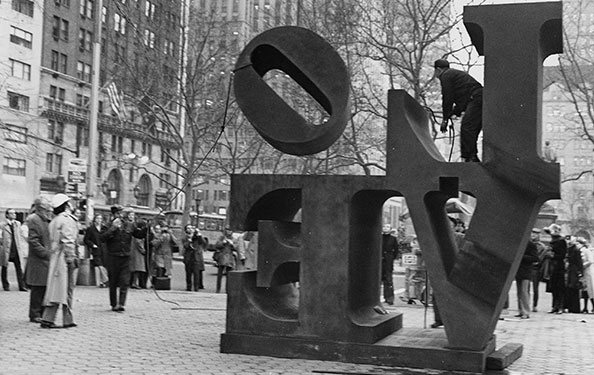 Robert Indiana, "Love," 1971, Doris C. Freedman Plaza, Central Park, Manhattan, NYC Parks Photo Archive
Robert Indiana, "Love," 1971, Doris C. Freedman Plaza, Central Park, Manhattan, NYC Parks Photo Archive
Now part of the Indianapolis Museum of Art’s permanent collection, Robert Indiana installed his famous sculpture at the entrance of Central Park in 1971. Though there are now over 40 versions of this sculpture on view around the world, this was the original.
we stood giant basketball hoops in Cadman Plaza,
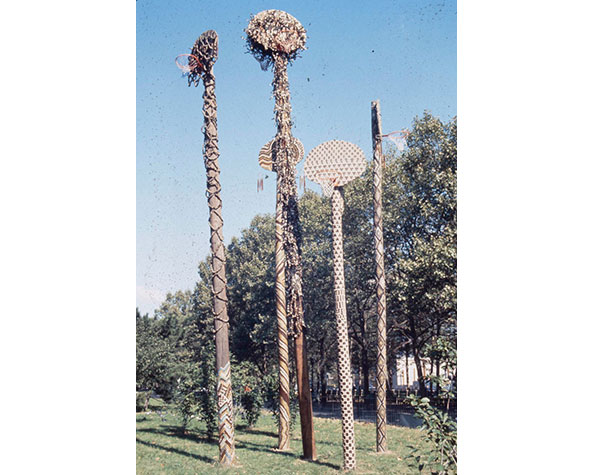 David Hammons, "Higher Goals," 1986, Cadman Plaza park, Brooklyn, photo by Pinkney Herbert and Jennifer Secor, courtesy of Public Art Fund
David Hammons, "Higher Goals," 1986, Cadman Plaza park, Brooklyn, photo by Pinkney Herbert and Jennifer Secor, courtesy of Public Art Fund
For Higher Goals, David Hammons covered five telephone poles mounted with a basketball backboard and net with bottlecaps. Hammons stated, “It takes five to play on a team, but there are thousands who want to play—not everyone will make it, but even if they don’t at least they tried.”
we added a hair salon to Petrosino Square,
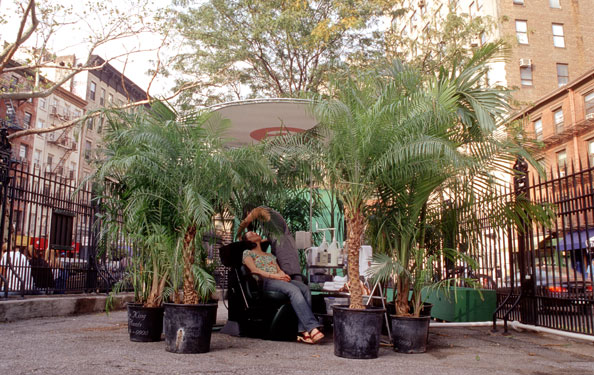 Nancy Hwang, "S," 2002, Petrosino Park, Manhattan, photo by Eileen Costa, courtesy of Nancy Hwang
Nancy Hwang, "S," 2002, Petrosino Park, Manhattan, photo by Eileen Costa, courtesy of Nancy Hwang
Nancy Hwang adapted intimate and often private activities to a public context. For S, she washed hair in an ad-hoc salon she established for one month in this downtown park. The project explored the meaning of human exchanges and civic responsibility, and broke down barriers between individuals blurring distinctions between the personal and professional.
we welcomed some squirrel-friendly bears to City Hall Park,
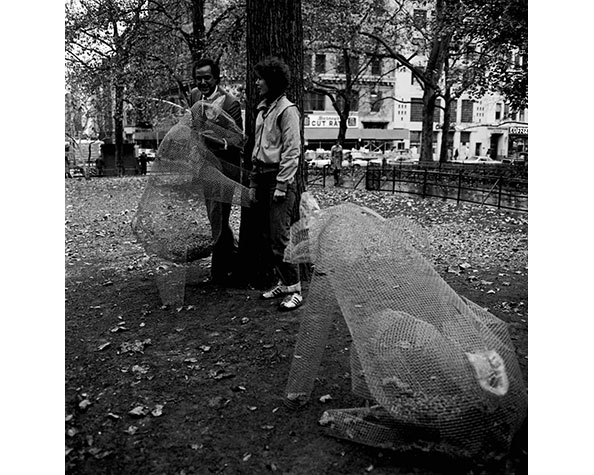 Christy Rupp, "Food Chain Piece," 1978, City Hall Park, Manhattan, NYC Parks Photo Archive
Christy Rupp, "Food Chain Piece," 1978, City Hall Park, Manhattan, NYC Parks Photo Archive
Christy Rupp’s Food Chain Piece (1978) consisted of translucent bear-shaped wire mesh sculptures laced with nuts to feed the squirrels of City Hall Park, merging prey and predator in an “animal behavioral sculpture.”
we brought 3,000 monarch butterflies to The Battery,
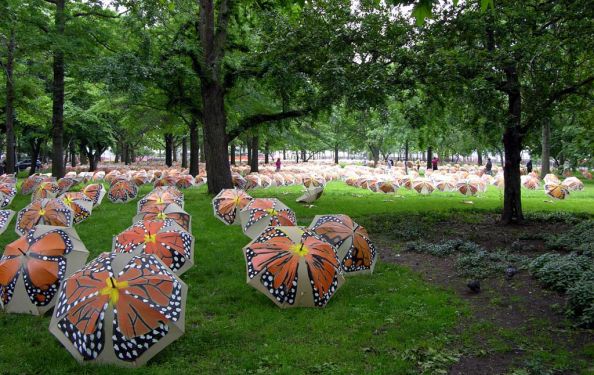 Victor Matthews, "Beyond Metamorphosis," 2004, The Battery (formerly Battery Park), Manhattan, A project sponsored by the Lower Manhattan Cultural Council, NYC Parks
Victor Matthews, "Beyond Metamorphosis," 2004, The Battery (formerly Battery Park), Manhattan, A project sponsored by the Lower Manhattan Cultural Council, NYC Parks
Victor Matthews installed nearly 3,000 umbrellas, each individually hand-painted with a rendering of a Monarch butterfly. “The piece explores themes of transformation, migration and regeneration,” says Matthews. “Butterflies make an obvious spiritual gesture that’s often overlooked: of a life that never ends and a spirit that never dies."
and placed "pink trash" in some of our largest parks.
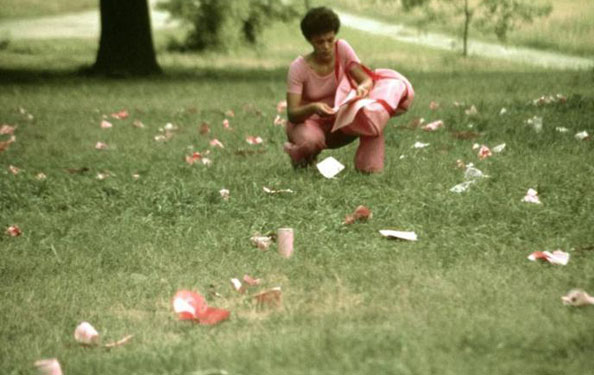 Maren Hassinger, "Pink Trash," 1982, Art Across the Park, Central Park, Manhattan, photo courtesy of Horace Brockington
Maren Hassinger, "Pink Trash," 1982, Art Across the Park, Central Park, Manhattan, photo courtesy of Horace Brockington
In 1982 and 1984, Art Across the Park commissioned site-specific works by young and emerging artists for parks across the city including Central Park, Van Cortlandt Park, Prospect Park, and Orchard Beach. Maren Hassinger picked up trash in parks and painted it baby pink. Returning to the sites dressed in pink, she placed the scraps back where she found them. Hassinger re-staged her performance in Prospect Park in 2017 as part of the Brooklyn Museum’s We Wanted a Revolution: Black Radical Women 1965–85.
We confronted our liberties,
 William Fulbrecht, "Bill of Rights: Access to Government," 1990, Foley Square, Manhattan, photo by Tim Karr, A project of the Public Art Fund
William Fulbrecht, "Bill of Rights: Access to Government," 1990, Foley Square, Manhattan, photo by Tim Karr, A project of the Public Art Fund
William Fulbrecht’s Bill of Rights project coincided with the 200th anniversary of the passage of the first 10 amendments to the United States Constitution. He cast colored concrete markers inscribed with text referring to the amendments and Supreme Court interpretations over time, making a powerful statement about the foundation and fragility of our liberties.
we took a stand against AIDS,
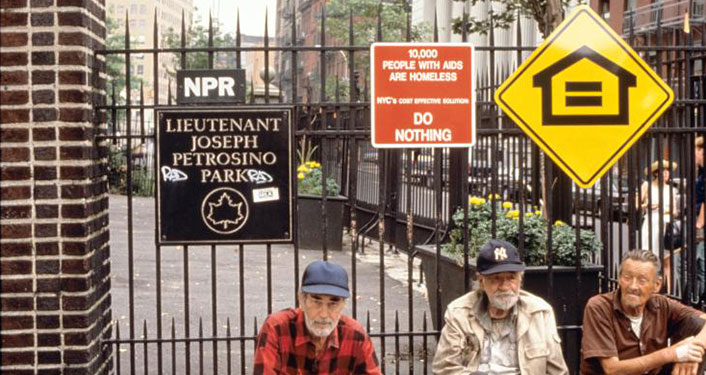 Gran Fury, "Petrosino Park Installation (Do Nothing and Stall with Men)," 1990, Petrosino Park, Manhattan, Manuscripts and Archives Division, The New York Public Library
Gran Fury, "Petrosino Park Installation (Do Nothing and Stall with Men)," 1990, Petrosino Park, Manhattan, Manuscripts and Archives Division, The New York Public Library
An artists' collective devoted to AIDS activism, Gran Fury was born out of ACT UP (AIDS Coalition to Unleash Power). This team of artists used the commercial language of posters, billboards, ads, and flyers in predominantly public spaces to pressure society and public figures to address the AIDS epidemic.
and brought the White House as a green house to The Battery.
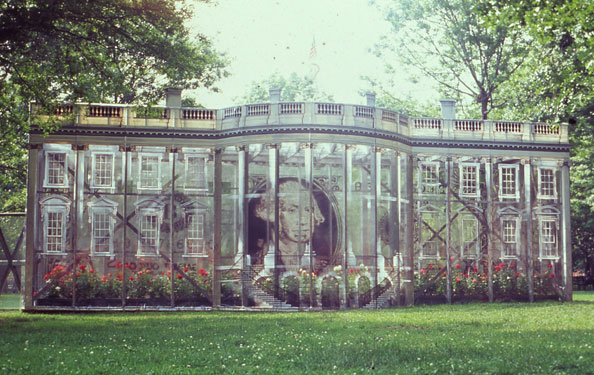 Karin Giusti, "The White House Green House," 1997, The Battery (formerly Battery Park0, Manhattan, photo courtesy of Karin Giusti
Karin Giusti, "The White House Green House," 1997, The Battery (formerly Battery Park0, Manhattan, photo courtesy of Karin Giusti
Karin Giusti’s The White House Green House was a greenhouse with an enlarged image of a dollar bill superimposed on that of the White House. The artist describes her piece as being about “the intricate nature of politics, money and the future of our environment.” It served as an actual greenhouse for 50 rosebushes, and held voter registration intermittently.
And it all started with this exhibit at Bryant Park.
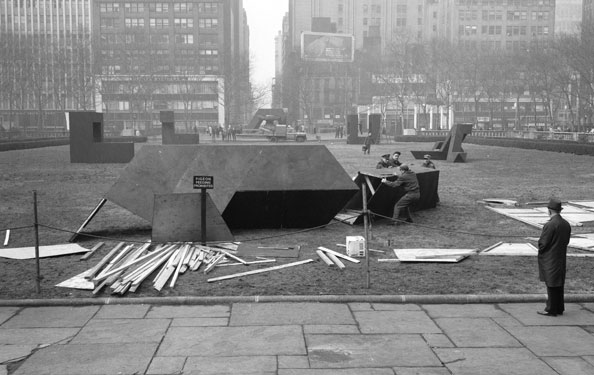 Tony Smith, 1967, Bryant Park, Manhattan, NYC Parks Photo Archive
Tony Smith, 1967, Bryant Park, Manhattan, NYC Parks Photo Archive
In 1967, the City of New York initiated a bold experiment to place contemporary art in its public parks. In January an exhibition at Bryant Park of Tony Smith’s minimalist geometric sculptures, which he called “presences,” inaugurated this endeavor.
Join the Movement
Our Art in the Parks program continues to display amazing works of public art across the city! Celebrate with us and find out how you can have your artwork displayed in NYC Parks